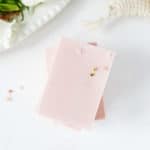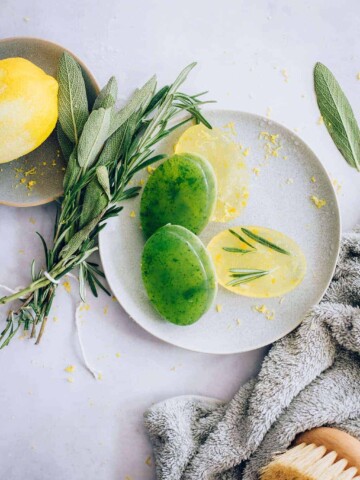Make a skin-soothing calamine soap recipe using a melt and pour base and gentle essential oils like chamomile, lavender, and tea tree. Calamine is known for calming itching and soothing eczema or sunburn, and this gentle soap helps replenish your skin's moisture barrier and repair damage at the same time.
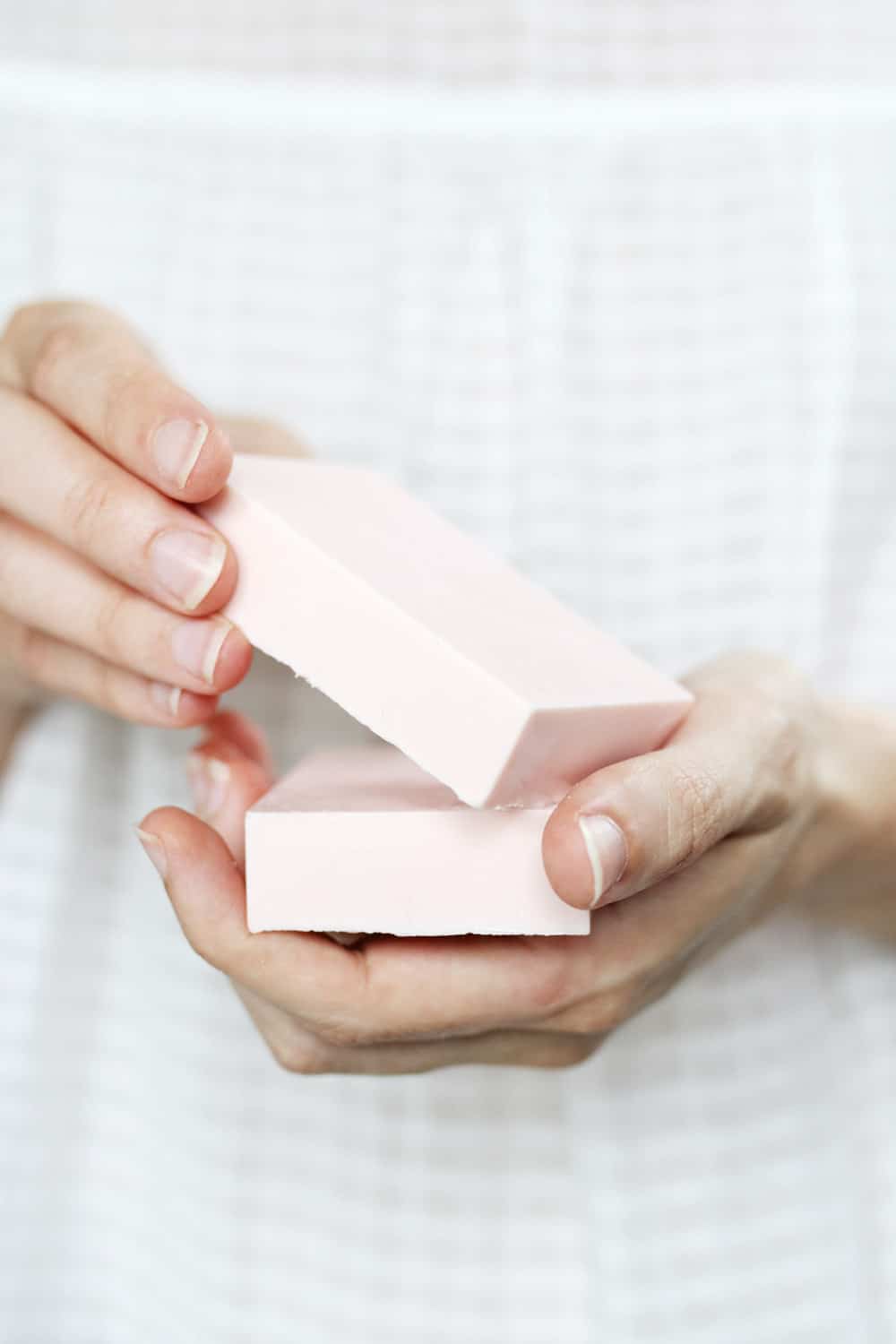
Do you ever feel like you might just have the world’s itchiest, most irritated skin? Yeah, me too.
Instead of reaching for pricey Lush’s Fresh Farmacy bars, I’ve been whipping up my own Lush copycat verison of their pale pink cleansing bar. Read on to make your own with chamomile to calm, lavender to soothe dry patches, and tea tree to keep skin clean and clear.
Jump to:
How To Make an Easy Calamine Soap Recipe
Calamine Soap Benefits
As the seasons change our skin goes into overdrive in an effort to rebalance itself to the new environmental conditions. With little moisture in the air, skin can quickly become dry, itchy, and irritated despite our best efforts.
Not to mention, hot showers and harsh soaps can make matters worse by stripping skin of its natural oils and breaking down its moisture barrier. When it comes to sensitive skin you need body products that actually nourish skin and promote healing.
Calamine soap offers several benefits for the skin, particularly for those with sensitive or problematic skin conditions. Here's a breakdown of the key benefits:
1. Soothes Irritation
Calamine is well-known for its calming and soothing properties. Calamine contains zinc oxide, which provides a cooling effect that can help alleviate itching from bug bites, poison ivy, or rashes.
2. Anti-inflammatory Properties
The components of calamine, primarily zinc oxide, have anti-inflammatory effects that can reduce redness and swelling. This makes calamine soap beneficial for inflammatory skin conditions such as acne or minor sunburns.
3. Provides Gentle Cleansing
Calamine soap cleanses the skin without stripping it of natural oils, which is crucial for maintaining the skin's barrier function and overall health. This gentle cleanser is suitable for everyday use, even for those with sensitive skin.
4. Helps Dry Out Blemishes
For oily and acne-prone skin, calamine can help by absorbing excess sebum and drying out pimples without causing excessive dryness in surrounding areas. The drying properties are primarily due to the presence of zinc oxide and iron oxide in calamine.
5. Mild Antiseptic Properties
Calamine provides a mild antiseptic effect, which is beneficial in a gentle soap to cleanse minor cuts and scrapes.
Ingredients

As a longtime fan of Lush’s Fresh Farmacy bars, I thought it was high time to make my own version minus the sodium lauryl sulfate, a foaming agent that's known for making skin irritation worse. And this calamine soap recipe couldn't be easier to make.
- 16 ounces melt and pour soap
- 30 drops chamomile essential oil
- 15 drops lavender essential oil
- 10 drops tea tree essential oil
- 2-4 tablespoons calamine lotion
- 2 tablespoons coconut oil
- 1 teaspoon or about 40 drops elderflower extract
Tea Tree Essential Oil
Malaleuca oil, also known as tea tree oil, has been used in Australia for its antiseptic and anti-inflammatory properties for almost 100 years [source]. Personally, I swear by it for soothing redness and encouraging wound healing, and I've found that it helps stop the itch when used in homemade bath and body products.
Chamomile Essential Oil
Chamomile oil is used for a variety of issues, such as ulcerative colitis, PMS, gastrointestinal disorders and osteoarthritis. But its chamomile's antioxidant and anti-inflammatory activities that make it so great for skin [source].
Calamine Lotion
The miracle ingredient in this soap is calamine lotion (yep, the same calamine you probably used on bug bites as a kid). Calamine gets its astringent and anti-itch properties from zinc oxide, a natural anti-inflammatory [source].
Because it works miracles on skin irritation and inflammation of all kinds, you’ll usually see it in summer skin products. But it’s just as good at healing dry winter skin.
When used regularly, calamine acts as a sort of second skin which forms a barrier between your skin and the elements, protecting you from irritants and locking in much-needed moisture.
Coconut Oil
When used as a topical moisturizer, coconut oil has been shown to increase skin hydration and increase skin surface lipid levels better than mineral oil [source]. In one study, 68% of patients saw an improvement in atopic dermatitis, making it significantly more effective than mineral oil at treating skin irritation [source].
Elderflower Extract
This ingredient can be a little tricky to get your hands on, but the benefits are well worth it. Elderflower possesses anti-inflammatory and antioxidant effects, thanks to organic acids, polyphenols and various chemical compounds, which nourish skin.
Plus, it doubles as a potent immune-booster, so save the leftovers and put it to good use during cold and flue season.
Instructions
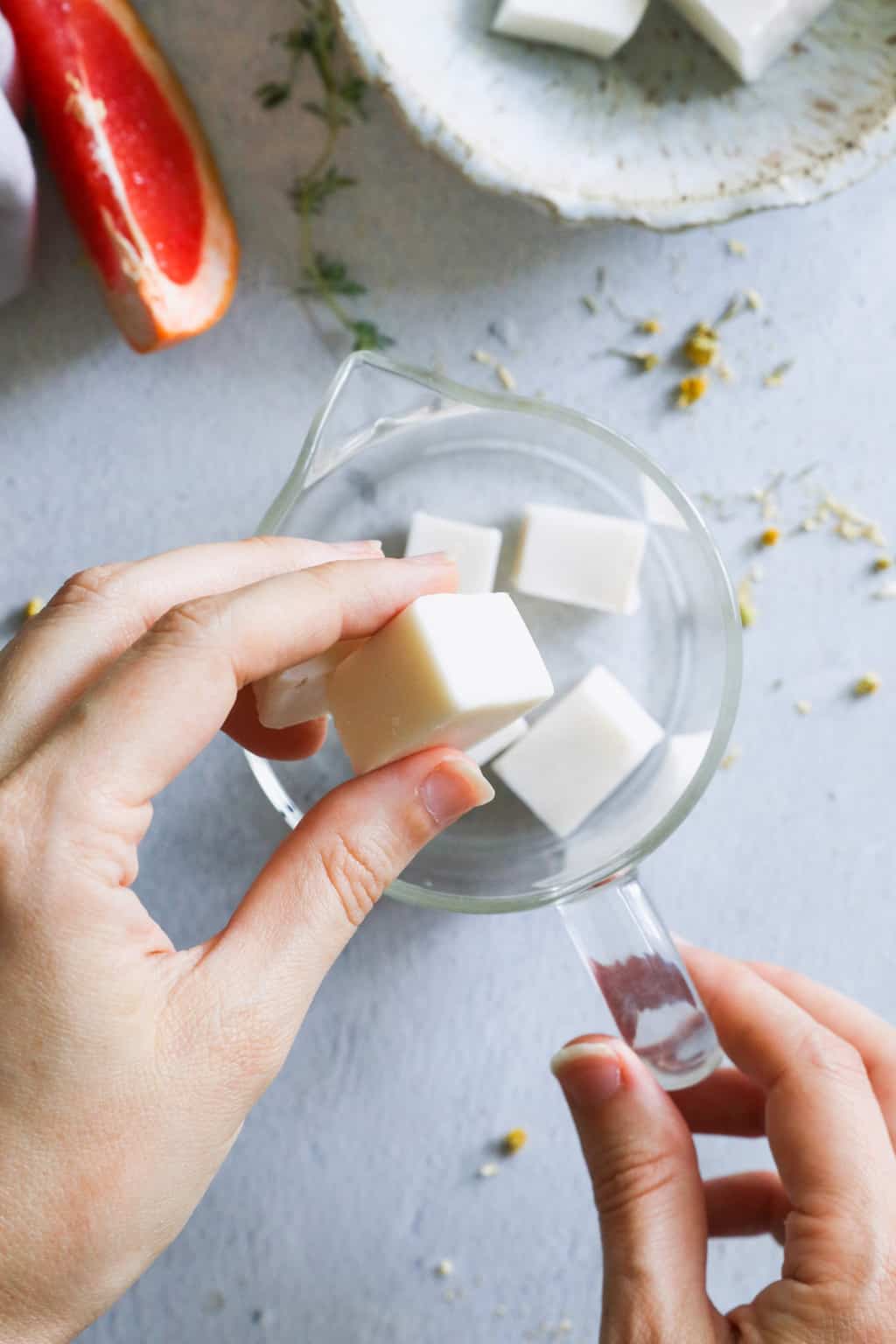
Step 1: Melt soap
Chop soap into small chunks and place in a medium-size microwave safe bowl. Melt the soap using short bursts in the microwave (stirring in between).
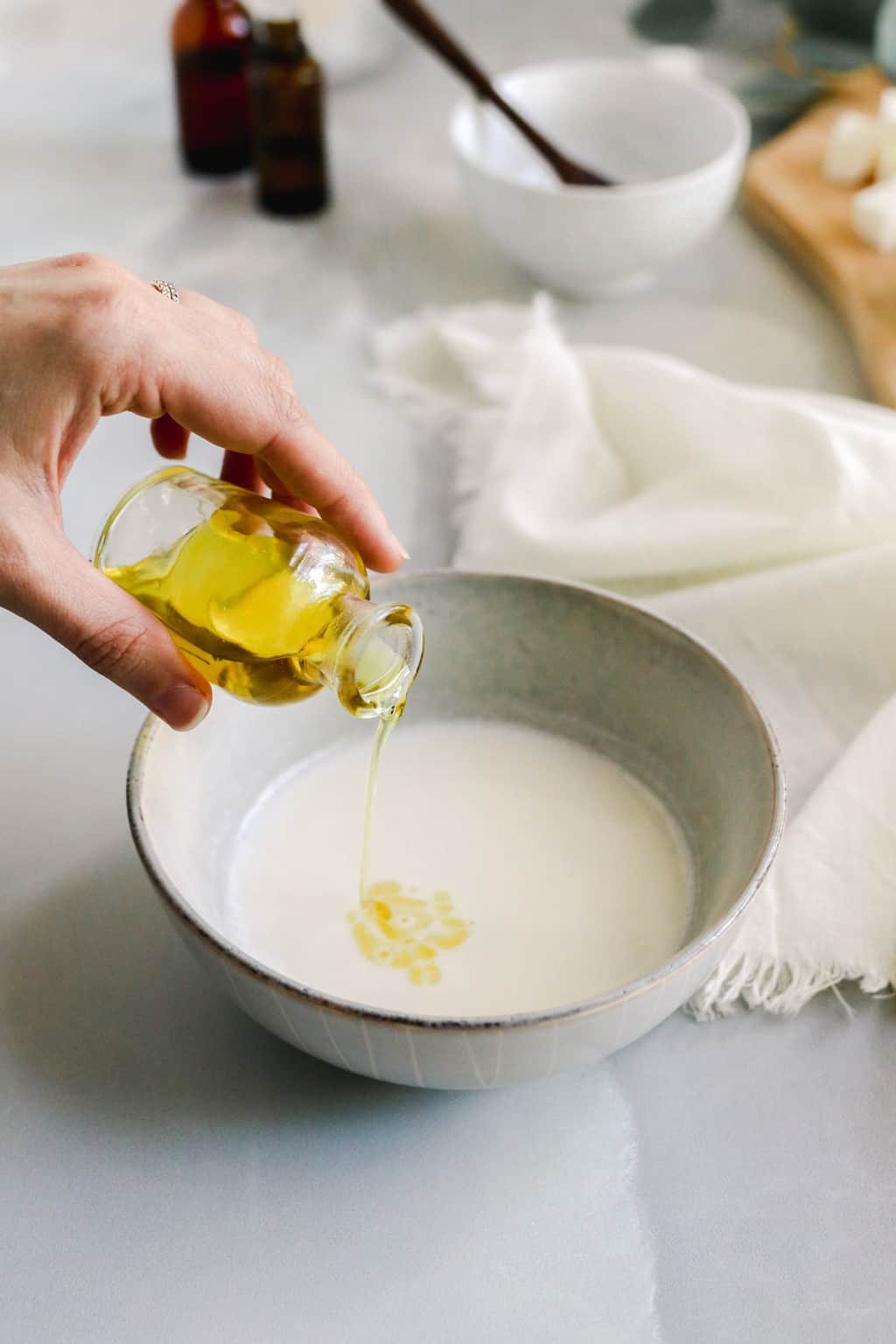
Step 2: Add remaining ingredients
Once the soap base is melted, add the calamine lotion and other ingredients, stirring continuously to break up any clumps.

Step 3: Pour into molds
Pour the soap mixture into your molds. To help remove any air bubbles that may have formed during mixing, tap the mold gently on the table or spray the surface with rubbing alcohol.
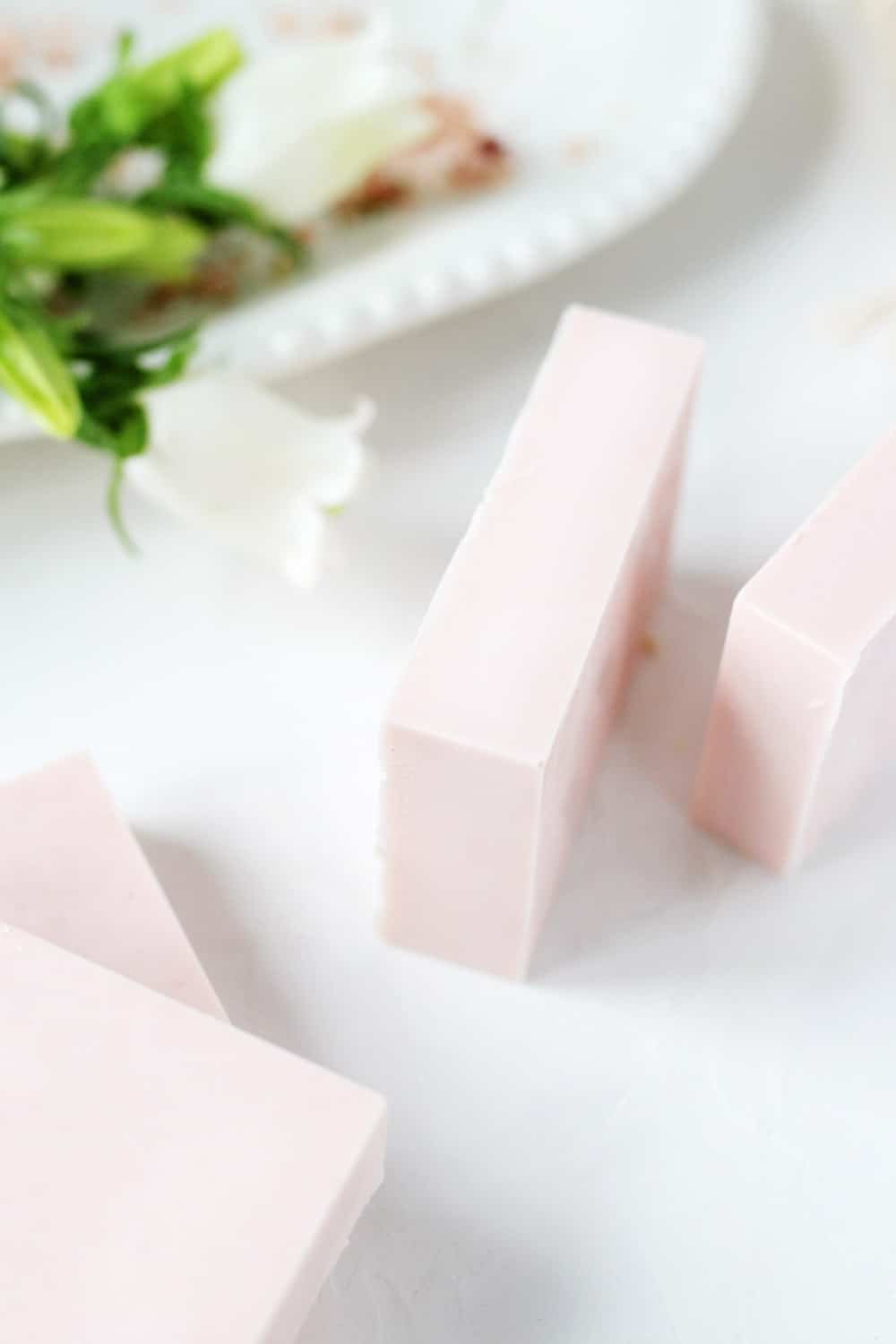
Step 4: Set the soap
Allow the soap to cool and harden for a few hours. You can speed up the process by placing the molds in the refrigerator. Remove the soap from the mold, cut into bars, and store in an airtight container.
Substitutions
Soap base — Any kind of melt and pour soap base should work for this recipe, but my favorites for itchy skin are goat milk, shea butter and oatmeal soap base. A white or glycerin base works well as it allows the pink color of the calamine to show.
Essential oils — Feel free to mix and match your own essential oils depending on what's best for your skin. Find more essential oils for sensitive skin here.
Elderflower extract — If you can't find, or would prefer not to spend the money on, elderflower extract, go ahead and leave it out! The recipe will still work.
Variation: Calamine Soap with Calamine Powder
You can order calamine powder from an online soap store and add it to your melted soap base. Just know that adding dry ingredients to soap base can change the texture of the soap, so keep it to about 1-2 tablespoons per pound of soap base.
Ingredients
- 1 pound melt and pour soap base
- 1-2 tablespoons calamine powder
- 50 drops lavender essential oil
- A few drops of liquid glycerin
Instructions
In a small bowl, mix the calamine powder with the liquid glycerin to create a smooth paste. This step helps prevent clumping and ensures even distribution throughout the soap.
Gradually add the calamine paste to the melted soap, stirring continuously. If you’re using lavender essential oil, add it at now and stir. Follow remaining steps as above.
You can also try adding calamine powder to a cold process soap recipe. Or for immediate itch relief, make your own calamine lotion with clay.
Variation: Sensitive Skin Soap Recipes
Soaps for sensitive skin need to be gentle, soothing, and free from harsh chemicals. Here are several ideas for melt and pour soap recipes specifically designed for sensitive skin:
1. Oatmeal & Honey Soap
Oatmeal gently exfoliates while soothing irritation, and honey is a natural humectant that moisturizes the skin. Lavender adds a calming scent and has anti-inflammatory properties.
2. Aloe Vera & Chia Seed Soap
Aloe vera is renowned for its soothing and healing properties, perfect for sunburned or irritated skin. Chia seeds are the perfect size for gently exfoliating sensitive skin.
3. Chamomile & Goat Milk Soap
Chamomile is anti-inflammatory and calming, making it ideal for sensitive and irritated skin. Goat milk soap base provides deep moisturization.
4. Calendula & Coconut Oil Soap
Calendula is known for its healing and soothing properties, often used in products for eczema or psoriasis. Coconut oil adds moisturizing benefits. Use clear or white melt and pour soap base and add 1 tablespoon calendula oil, 1 tablespoon coconut oil, and dried calendula petals.
5. Almond Oil + Clay Face Soap
This goat milk soap with almond oil is nourishing on the skin and gentle enough to use on your face.
6. Honey + Goat Milk Soap
Goat’s milk is high in fatty acids that help repair the skin barrier, reduce inflammation, and maintain hydration. Honey adds skin-calming properties.
7. Argan Oil & Rosewater Soap
Argan oil is rich in vitamin E and fatty acids, making it an excellent moisturizer for dry or sensitive skin. Rosewater helps maintain the skin's pH balance and has anti-inflammatory properties.
8. Blueberry & Yogurt Soap
Yogurt contains lactic acid, which can gently exfoliate without irritation, while blueberries are antioxidant-rich and help protect the skin. Use a clear soap base and add 1 tablespoon yogurt powder and 1 tablespoon blueberry powder.
FAQ
Typically, you can add 1 to 3 teaspoons of calamine powder per pound of soap base. It's important to first mix the calamine powder with a little glycerin or oil to create a slurry before adding it to the melted soap base to ensure smooth integration without clumps.
Calamine powder can give a slight pink hue to the soap, depending on the quantity used and the opacity of your base. If you use a clear base you’ll notice the color more.
To prevent settling, create a mixture of calamine and glycerin, and add it to the soap base when it’s cooled but still liquid. Stir thoroughly before pouring into molds. Pouring at a slightly cooler temperature can also help suspend the particles evenly.
Melt and pour soaps generally have a shelf life of around one year. However, the actual shelf life can depend on the other ingredients used. Store your soap in a cool, dry place away from direct sunlight to maximize its shelf life.
Next up?
Add these DIY moisturizing lotion bars to your skincare regimen to fight free radicals and lock in moisture.
Melt + Pour Calamine Soap Recipe
Equipment
- Medium bowl
- Soap mold
Materials
- 12 ounces melt and pour soap
- 30 drops chamomile essential oil
- 15 drops lavender essential oil
- 10 drops tea tree essential oil
- 2 - 4 tablespoons calamine lotion
- 2 tablespoons coconut oil
- 1 teaspoon elderflower extract
Instructions
- Chop soap into small chunks and place in a medium-size microwave safe bowl. Microwave in 30-second intervals until just melted.
- Add remaining ingredients and stir well to combine.
- Pour into your soap mold and let cool completely.
- Remove from mold and store in an airtight container for up to 3 months.

